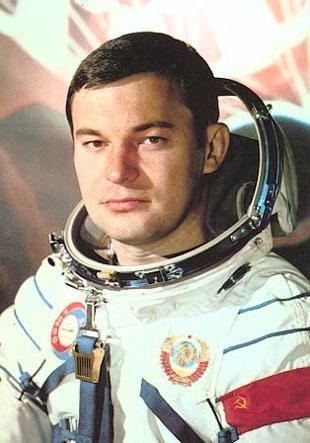Yury Romanenko
Russian - (RFSA)
Retired
Date of Birth: Aug. 1, 1944
Age: 81
Yury Viktorovich Romanenko (Russian: Ю́рий Ви́кторович Романе́нко, Jurij Viktorovič Romanenko; born August 1, 1944) is a former Soviet cosmonaut, twice Hero of the Soviet Union (March 16, 1978 and September 26, 1980). Over his career, Yury Romanenko spent a total of 430 days 20 hours 21 minutes 30 seconds in space and 18 hours in space walks. In 1987 he was a resident of the Mir space station, launching on Soyuz TM-2 and landing aboard Soyuz TM-3. He remained on Mir for 326 days that was the longest stay in space at that time. His son, Roman Romanenko is also a cosmonaut, and has become the third second-generation space traveler on Soyuz TMA-15 in May 2009.
Soyuz-U | Soyuz 26
Russian Federal Space Agency (ROSCOSMOS) | RussiaBaikonur Cosmodrome, Republic of Kazakhstan
Dec. 10, 1977, 1:18 a.m.
Status: Success
Mission:
Soyuz 26 carried Salyut 6 EO-1, which was the first long-duration expedition to the Salyut 6 space station. The mission began on December 10, 1977, 01:18:40 UTC, launching Commander Yuri Romanenko and Flight Engineer Georgi Grechko into orbit. They docked with the station the next day. During their 96-day stay in orbit, crew performed the first Soviet spacewalk since 1969 with the purpose of inspecting one of the stations docking ports. They also performed Earth observation, carried out various experiments and tested new navigation system. EO-1 crew was visited by Soyuz 27 and Soyuz 28 crews; the first ever refueling of the station was performed by an uncrewed cargo ship Progress 1 during the mission. EO-1 crew swapped vehicles with the Soyuz 27 crew, which allowed for a longer stay in orbit. EO-1 crew returned in the Soyuz 27 spacecraft, landing safely back on Earth on March 16, 1978, 11:18:47 UTC.
Low Earth OrbitSoyuz-U | Soyuz 27
Russian Federal Space Agency (ROSCOSMOS) | RussiaBaikonur Cosmodrome, Republic of Kazakhstan
Jan. 10, 1978, 12:26 p.m.
Status: Success
Mission:
Soyuz 27 carried Salyut 6 EP-1 mission to the Salyut 6 space station. The mission began on January 10, 1978, 12:26:00 UTC, launching Commander Vladimir Dzhanibekov and Flight Engineer Oleg Makarov into orbit. They docked with the station the next day. During their 5-day stay on the station, crew performed various scientific and technological experiments. EP-1 crew swapped vehicles with the Soyuz 26 (EO-1 expedition) crew, which allowed for a longer stay in orbit for EO-1. EP-1 crew returned in the Soyuz 26 spacecraft, landing safely back on Earth on January 16, 1978, 11:24:58 UTC.
Low Earth OrbitSoyuz-U | Soyuz 38
Russian Federal Space Agency (ROSCOSMOS) | RussiaBaikonur Cosmodrome, Republic of Kazakhstan
Sept. 18, 1980, 7:11 p.m.
Status: Success
Mission:
Soyuz 38 was the 12th mission to visit the Salyut 6 space station and carried the EP-8 crew, which visited the long-duration Soyuz 35 resident crew. The mission began on September 18, 1980, 19:11:03 UTC, launching Commander Yuri Romanenko and Research Cosmonaut Arnaldo Tamayo Méndez, the first Cuban cosmonaut, into orbit. They docked with the station the next day. During their 7-day stay on the station, EP-8 crew carried out medical and other experiments, including Earth and solar observation, plant and crystal growing. The mission concluded with a safe landing back on Earth on September 26, 1980, 15:54:27 UTC.
Low Earth OrbitSoyuz-U2 | Soyuz TM-2
Soviet Space Program | RussiaBaikonur Cosmodrome, Republic of Kazakhstan
Feb. 5, 1987, 9:38 p.m.
Status: Success
Mission:
Soyuz TM-2 was the first crewed flight of the new Soyuz TM spacecraft and the second long-duration mission to Mir space station. The mission began on February 5, 1987, 21:38:16 UTC, launching Commander Yuri Romanenko and Flight Engineer Aleksandr Laveykin into orbit. They docked with Mir two days later. During their stay there, new module was docked to the station. Crew was visited by several Progress resupply missions and by a crewed Soyuz TM-3 mission. The mission concluded with a safe landing back on Earth on December 29, 1987, 09:16:00 UTC.
Low Earth OrbitSoyuz-U2 | Soyuz TM-3
Soviet Space Program | RussiaBaikonur Cosmodrome, Republic of Kazakhstan
July 22, 1987, 1:59 a.m.
Status: Success
Mission:
Soyuz TM-3 was the third mission to Mir space station. The mission began on July 22, 1987, 01:59:17 UTC, launching Commander Alexander Viktorenko, Flight Engineer Aleksandr Aleksandrov and Research Cosmonaut Muhammed Faris, the first Syrian cosmonaut, into orbit. They docked with Mir two days later. During their stay there, crew conducted Earth observation, medical and other scientific experiments. The mission concluded with a safe landing back on Earth on July 30, 1987, 01:04:12 UTC.
Low Earth OrbitThe Roscosmos State Corporation for Space Activities, commonly known as Roscosmos, is the governmental body responsible for the space science program of the Russian Federation and general aerospace research. Soyuz has many launch locations the Russian sites are Baikonur, Plesetsk and Vostochny however Ariane also purchases the vehicle and launches it from French Guiana.
Falcon 9
CSG-3
Space Launch Complex 4E - Vandenberg SFB, CA, USACSG-3 is an Earth observation satellite for the Italian Space Agency, part of a reconnaissance constellation using synthetic aperture radars operatin…
Long March 7A
Shijian 29 A-B
201 - Wenchang Space Launch Site, People's Republic of China2 satellites officially described as for "demonstration of new technologies for spatial targets detection" purposes.
Long March 4B
Tianhui 7
Launch Area 94 (SLS-2 / 603) - Jiuquan Satellite Launch Center, People's Republic of ChinaA satellite officially described as for cartography purposes, details TBD.
Soyuz 2.1b/Fregat-M
AIST-2T 01 & 02
Cosmodrome Site 1S - Vostochny Cosmodrome, Siberia, Russian FederationA pair of Russian optical Earth observation satellites built by the Progress Rocket Space Centre for obtaining stereo images of the Earth's surface, …
Long March 3B/E
Fengyun-4C
Launch Complex 2 (LC-2) - Xichang Satellite Launch Center, People's Republic of ChinaChina's geostationary meteorological satellite program FY-4 (Feng Yun 4) is the second generation of chinese geostationary meteorological satellites.




